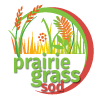Our sod has been growing in the middle of South Dakota for decades and rated as “Virgin Prairie Grass”. This premium virgin prairie grass sod has been rated as extremely high quality and is classified as being a shortgrass with some mixed-grasses.
Prairie plants will grow best in full sunlight for most of the day. The beautiful thing about prairie fields is that they will grow on many different soil types including wet, dry, fertile, poor nutrients, fertile, sandy or rocky.
The best chance of a healthy prairie sod installation is to have near similar conditions. However, mature prairie sod like our virgin prairie sod, already has that ability to evolve into its new environment.
The site preparation varies greatly pending your local soils and current plant types. For a successful soil prep you will need to remove all existing vegetation. Depending on location you can plow, burn, or if you have time, cover with plastic and choke new seed germination out. We try not to use herbicides, but sometimes it’s needed in combination with the above options. Find some comfort in not usually having to use herbicides in coming years.
The time to cut prairie grass is different if you are starting from seed. An established prairie grass field should be mowed every 3 to 5 years at a 6’ – 8” height. If you get some invasive weeds, you can mow mid-spring. You can watch for the perfect mowing time if you watch the Maple tree leaves when they just start to pop out of their seed pod. The reasoning is that native prairie grass starts later than aggressive plants. By mowing the aggressive plants you’re allowing the wanted native prairie plants to have a head start.
Burning sounds counterproductive, but if your area has an option to this, it is actually good for your sod every 3 – 5 years. A couple of good reasons, 1) prairie plants are resistant to burning even if they are starting to green up, 2) minimizes the duff layer (decaying matter, 3) controls unwanted weeds, and adds nitrogen to the soil.
If you can’t burn, you can mow.
Our prairie grass sod is primarily shortgrass with some transitional mixed-grass. This height of native plants lends itself well for incorporation into traditional lawns to save water, labor, and pesticides while still being beautiful. It also serves well for erosion control or amending poor soils.
Shortgrass prairie is an ecosystem found in the Great Plains. The prairie includes lands to the west near the lower elevations of the Rocky Mountains and as far east as Nebraska. The prairie stretches through areas of Alberta Canada, Wyoming, Montana, N. Dakota, S. Dakota, and Kansas. You can even find parts of higher altitudes of Colorado, Oklahoma, Texas, and New Mexico.
Mixed-grass is richer in ecological diversity and is typically found between two shortgrass and tallgrass. It may be small patches or wide swathes. This blend of mixed-grasses is simply a blend of those to ecosystems.
Tallgrass prairie is an ecosystem native to central North America. Prior much of the prairie grass being plowed under for farming crops, tallgrass prairies covered much of the American Midwest.

There are basically two groups of plant growth, cool and warm grasses. The definition doesn’t mean cool grasses grow in the north and warm in the south, it really is defining when their growth distribution happens.
Cool grass season (pending area & plant species) has a longer growing time like March – November peeking in May/Jun and then also in late October/November.
Warm grass season (pending area & plant species) has a shorter growing time like mid-April – early October peeking in July, and then ends early October.
Established virgin prairie fields like ours, need Father Time and Mother Nature to evolve over decades and even centuries. Growing native prairie grass from seed can prove to be very difficult, even to accomplished agriculturists or ranchers. There has to be a solid understanding of seed options etc. Even then it will take years before it evolves into good prairie fields.
There are so many advantages to prairie grass and wildflowers it’s hard to touch on all of them.
Ecological benefits: wildlife habitat, plant diversity, ground water retention, water filtration, nutrient improvement, water and wind erosion control, carbon storage, air purification, mediation of temperature.
Other benefits:
Prairie grass can be used for economic benefits such as grazing, seed harvesting, and government/agency incentive programs. Of course we need to mention the sheer beauty of nature doing what it does so well in taking care of our earth while being jaw dropping gorgeous.
See Financial Benefits
Normal planting time is typically in late fall. This may differ pending your location. Early spring is an option too. If you’re seeding, and want wildflowers, you will have to pretreat those seeds to germinate. If you choose to sod, all the seeds and roots are ready to go.

All rights reserved 2021 | Developed by Where in Guate
Prairie Grass Sod: 2000 N. North Drive, Sioux Falls, SD 57104 | info@PrairieGrassSod.com | Tel: +(605) 728 2970